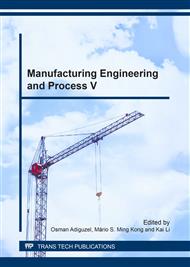[1]
N. Dowling: Mechanical behavior of materials. 4th ed., New Jersey: Prentice Hall; (2012).
Google Scholar
[2]
G.K. Sigworth and T.A. Kuhn: Grain Refinement of Aluminum Casting Alloys, AFS Transactions, Vol. 115(2007), pp.1-12.
Google Scholar
[3]
A. Merati: A study of nucleation and fatigue behavior of an aerospace aluminium alloy 2024-T3", International Journal of Fatigue, Vol. 27(2005), pp.33-44.
DOI: 10.1016/j.ijfatigue.2004.06.010
Google Scholar
[4]
T. Hanlon, Y. -N. Kwon, S. Suresh: Grain size effects on the fatigue response of nanocrystalline metals Scripta Materialia, Vol. 49 (2003), p.675–680.
DOI: 10.1016/s1359-6462(03)00393-2
Google Scholar
[5]
T. Hanlon, E.D. Tabachnikova and S. Suresh: Fatigue behavior of nanocrystalline metals and alloys, International Journal of Fatigue, Vol. 27 (2005), p.1147–1158.
DOI: 10.1016/j.ijfatigue.2005.06.035
Google Scholar
[6]
L. Wagner: Mechanical surface treatments on titanium, aluminum and magnesium alloys, Materials Science and Engineering A, Vol. 263 (1999) p.210–216.
DOI: 10.1016/s0921-5093(98)01168-x
Google Scholar
[7]
R.S. Rana, P. Rajesh and S. Das: Reviews on the influences of alloying elements on the microstructure and mechanical properties of aluminum alloys and aluminum alloy composites, International Journal of Scientific and Research Publications, Vol. 2 (2012).
Google Scholar
[8]
J. Gautheir, P.R. Louchez and F.H. Samuel: Heat treatment of 319. 2 aluminum automotive alloy: part 1, Solution heat treatment, Cast Metals, Vol. 8 (1994), p.91–106.
DOI: 10.1080/09534962.1995.11819197
Google Scholar
[9]
M.H. Mulazimoglu, N. Tenekedjiev, B.M. Closset and J.E. Gruzleski: Studies on the minor reactions and phases in strontium-treated aluminum–silicon casting alloys, Cast Metals, Vol. 6 (1993), pp.16-28.
DOI: 10.1080/09534962.1993.11819122
Google Scholar
[10]
F.H. Samuel, A.M. Samuel and H.W. Doty: Factors controlling the type and morphology of Cu-containing phases in 319 Al alloy, AFS Transactions, Vol. 104 (1996), p.893–901.
Google Scholar
[11]
P.N. Anyalebechi,: Analysis of the effects of alloying elements on hydrogen solubility in liquid aluminum alloys". Scripta Materialia, Vol. 33 (1995), p.1209–1216.
DOI: 10.1016/0956-716x(95)00373-4
Google Scholar
[12]
C.H. Cacers, M.B. Djurdjevic, T.J. Stockwell and J.H. Sokolowski: The effect of Cu content on the level of microporosity in Al–Si–Cu–Mg casting alloys". Scripta Materialia, Vol. 40 (1999), p.631–637.
DOI: 10.1016/s1359-6462(98)00492-8
Google Scholar
[13]
Q.G. Wang, D. Apelian and D.A. Lados,: Fatigue Behavior of A356/357 Aluminum Cast Alloys: Effect of Microstructural Constituents - Part II Journal of Light Metals Vol. 1(2001) , pp.85-97.
DOI: 10.1016/s1471-5317(00)00009-2
Google Scholar


